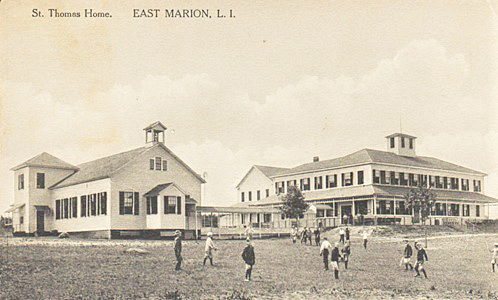For new oral history project, StoryCorps is collecting stories from East Marion

The Oysterponds Historical Society and East Marion Community Association have teamed up to collect oral histories of the hamlet of East Marion.
Audio recordings are uploaded to StoryCorps, an online interview archive housed at the Library of Congress’ American Folklife Center in Washington, D.C. The collection includes tens of thousands of recorded conversations from across the country and around the world.
“The East Marion Community Association always had a focus on history and we had previously done some oral history things, mainly video, so it wasn’t a new idea for us really, but the historical society had sort of challenged us to figure out a way to engage more people in East Marion,” said Ellen Zimmerman, who has helped spearhead the project along with Sandra Saiegh since it was launched last year. Ms. Saiegh is a former trustee with OHS and Ms. Zimmerman is the president of EMCA.
“We kind of got together and developed this idea of doing more oral histories and because it was the beginning of the pandemic, we had to figure out a way to do it without doing anything face to face,” Ms. Zimmerman added. “But we knew about StoryCorps and it turned out that StoryCorps had the tools that made it possible for us to do this remotely … It would solve several problems that we’d previously had, one of which was, once we’ve got this material, what do we do with it and how do we protect it?”
StoryCorps preserves the interviews with the Library of Congress — the community groups don’t have the servers or equipment to store and preserve recorded materials over time, Ms. Zimmerman said — and the platform is open and easily accessible to the public. The pandemic made it difficult to “get some of the older people on tape,” but interview audio and photos of the people involved can be gathered and uploaded online remotely.
About 10 East Marion volunteers helped reach out to and interview people for the project, even as word of the project was spread via mailing lists from EMCA and OHS.
“We’ve got some really interesting stories of how people found out about East Marion and how they came to be in East Marion and what was important to them about it,” Ms. Zimmerman said.
Ms. Zimmerman said she thought the interviews might “unearth some material things that people might not know what to do with, but then, you know, if it was an interesting object or document, it might be something that we’d want to include in the historical society collection. That was another sort of byproduct of collecting the oral histories.”
She described a participant who grew up in East Marion and later sent scans of East Marion memorabilia, some of which were featured in a summer exhibit. Another interviewee, an East Marion woman with scrapbooks about a local homemakers club, shared documentation and photos that ended up in the historical society collection.
“We find these pearls … We can add photographs that people may have at home that can get lost,” Ms. Saiegh said. “That’s also something that, again, you know, preservation and memories for people to enjoy.”

One woman, whose family purchased a summer home in the hamlet, focused on the “sense of community” in East Marion in her interview, Ms. Zimmerman said.
“Everybody sort of socialized with everybody else. And what her father used to always say was, no one wears their pocket in East Marion, meaning everybody’s the same,” she said. “It doesn’t matter if you’ve got lots of money, you don’t have lots of money. Everybody helps everybody else. And I’ve always thought about that as sort of talking about the spirit they found out here.”
The project can help East Marion residents and anyone else who might be interested learn more about the hamlet, Ms. Saiegh added.
“East Marion is kind of the town people drive through to get to. You know, they need to get to the ferry or they need to get to Greenport and they don’t stop in East Marion, so we always try to find ways to bring awareness of East Marion,” she said. “Part of the strategic plan of the Oysterponds Historical Society has been community engagement.”
She and Ms. Zimmerman emphasized the importance of preserving the hamlet’s history.
“The history of a place can get lost when people move away and when they pass away. Their families may remember things but there are things that the whole community can forget and one of the objectives of these community associations is to preserve the history of this place, because it has a pretty long and interesting history,” Ms. Zimmerman said.
The community association and historical society plan to ramp up the ongoing project this winter. Anyone interested in sharing stories about East Marion — whether as an interviewer or an interviewee — can visit the websites of either EMCA or OHS.
“Whether they still live here or not, we’d like to hear about their family stories and what was important to them, just so that these memories of this place are not lost. And maybe it would inspire other people to do the same thing about where they live,” Ms. Zimmerman said.








